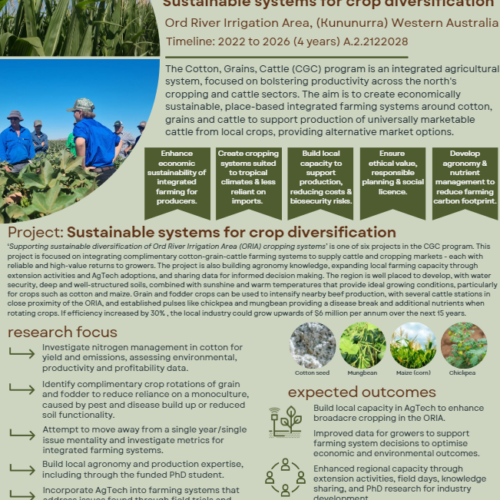
- Reference # A.2.2122028
- Project Status Current
- Timeframe 3 years 10 months (2022 to Aug 2026)
- Project manager Ian Biggs
- CRCNA Funding $1,100,000
- Total project value $2,965,000
- Project research participant Northern Australia Crop Research Alliance Pty Ltd (NACRA) ; University of Queensland ; WA Govt Dept. Primary Industries and Regional Development ; Advanced Agricultural Systems (SwarmFarm)
- Project research co-funder Cotton Research and Development Corporation (CRDC) ; Grains Research and Development Corporation (GRDC)
- Research Programs 2. New and developing industries in Northern Australia
- Location Kununurra, WA
- Cotton Grains Cattle program
- Agriculture
- Broadacre cropping
Summary
This project is part of the CRCNA’s integrated farming systems – Cotton, Grains and Cattle program.
The Ord River Irrigation Area (ORIA) lays claim to the highest water security in Australia, thanks to the immense water storage from Lake Argyle. The high level of water security, deep and well-structured soils, combined with sunshine and warm temperatures provide ideal growing conditions, particularly for crops such as cotton and maize.
During the past 5 years of research, planting cotton in the wet season has consistently demonstrated high yields. This is due to flowering occurring during the optimal early dry season periods of March through to May. Previous to Bollgard 3 (BG3) technology, this flowering window would be at high risk from Lepidoptera pest damage, which has previously held back a northern cotton industry. The success of the cotton crop agronomically, as well as supplying two commodity markets, each with reliable high-value returns to growers, provides an opportunity to establish an integrated cotton-grain-cattle farming system whereby each component compliments the other.
This project aims to move away from a single year/single issue mentality and investigate several metrics in an integrated farming system. The primary issues to be addressed include identifying suitable rotations with cotton and maize, optimising N inputs, incorporating Ag Tech into a farming system, building local skills and expertise, and inclusion of a PhD student.
Nitrogen management in cotton is to be investigated as this has implications for productivity, profitability, and the environment. Crop N availability is key driver of crop yield, but N is also the largest contributor of GHG emissions from a cotton crop.
The project will also building local capacity through the adoption of Ag Tech in the cotton/grain system. It is anticipated that adoption of this technology will enhance broadacre cropping in the ORIA. A focus of this project will be to look at potential technologies that can be validated or demonstrated to either enhance trials being conducted and/or address systems issues identified through engagement.
In addition to boosting local skills and capacity in the farming community through extension of knowledge and lessons gained from the project onto the local farming community to, an important part of this project will be supporting a PhD candidate to undertake some of the R&D required. While to be based at The University of Queensland, in southern Queensland, all field work will occur in Kununurra and the knowledge gained will be directly applicable to cropping in the ORIA.
Expected outcomes
Investigating cotton Nitrogen management and extending the findings through field days, workshops and seminars will lead to the establishment of best practise for cotton, specific to the Ord. If efficiency increased by 30% the estimated benefit across the industry is upwards of $6m per annum over the next 15 years as more land is developed.
Current GRDC supported research in maize suggests efficiency improvements of 30% as quite achievable. Fertiliser efficiencies improving by 30% could also reduce the carbon footprint by >50%, as fertiliser losses are the greatest contributor to the carbon footprint of irrigated agriculture.
Complimentary crop rotations of grain, fodder, and pulse crops will reduce the reliance on a monoculture which is at an increased exposure detrimental impact caused by pest and disease build–up and/or reduced soil functionality. Grain and fodder crops can also be used to intensify nearby beef production, with several cattle stations in close proximity. Pulse crops such as chickpea and mungbean are established cash crops in the ORIA and provide a disease break and additional nutrients to the subsequent crop.
Growers will have data to support farming system decisions about how to optimise the system for both economic and sustainable outcomes.
The scope of study in this work provides ample opportunity for the publication of one (or more) PhD’s resulting in further industry development.
updates
CRCNA Cotton, Grains and Cattle program
Get the latest updates on the Cotton, Grains and Cattle program.
Publications
18 July 2024
Cotton, Grains, Cattle program: Supporting sustainable diversification of Ord River Irrigation Area (ORIA) cropping systems
Type: Fact sheet
Industry: Cotton Grains Cattle program, Agriculture, Beef, Broadacre cropping


